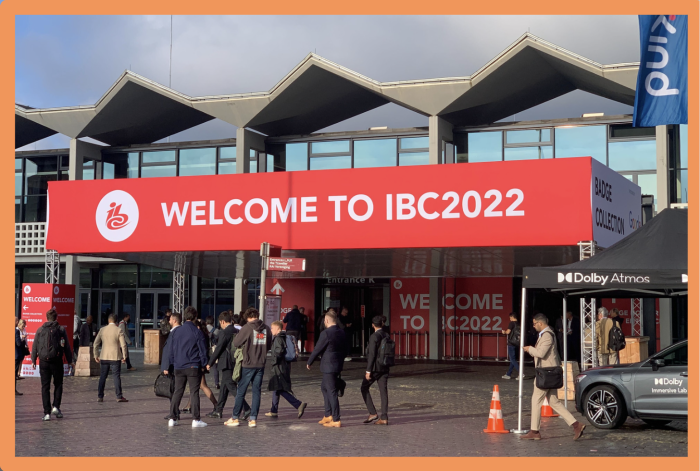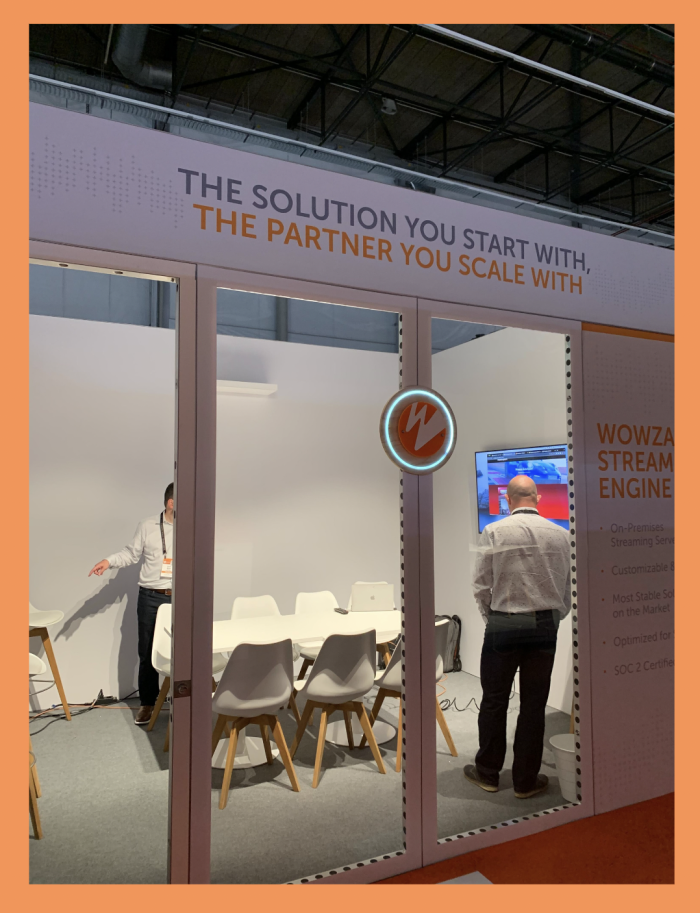IBC 2022: Key Trends and Takeaways

The 2022 International Broadcasting Convention (IBC), held in person for the first time since 2019, was back at the RAI Convention Center in Amsterdam with thousands of attendees and an air of excitement for the streaming industry’s future.
This year had a lower attendance of 37,071 people from 170 countries compared to over 56,000 in past years, but I believe this improved the quality of traffic and interactions. The event was also only four days instead of five, which resulted in a more qualified and engaged audience. Attendees booked more meetings out of genuine interest than mere curiosity.
The Wowza team’s experience was tremendously positive. It was exciting being back amongst the best of the best in the streaming industry and we had a fully booked meeting schedule throughout the show, largely thanks to buzz around the release of Wowza Video and our recent acquisition of Flowplayer.
Over the course of the convention, I noticed a few key trends that will certainly shape the industry’s path going forward.
Table of Contents
Top Trends at IBC 2022

FAST Is Growing Fast
Free ad-supported television (FAST) is growing more rapidly than even subscription-based video on demand (SVOD) in terms of both viewers and content providers. Though the concept is nothing new, many companies announced intentions to adopt this business model by making linear streaming channels out of their VOD assets.
Honestly, FAST was arguably the convention’s biggest buzzword. Founder and managing director of Antonik Digital, Nathalie Lethbridge, described FAST as a combination of streaming and traditional TV viewing, resulting in a “lean back” experience consumers are fond of. For example, playlists are a key component of FAST channels, and Pluto TV has several playlist-like channels dedicated to specific genres and programs, including true crime and SpongeBob SquarePants. This way, viewers can watch continuous episodes of their favorite content without having to search or toggle between different titles.
Omedia analysts have predicted that FAST will generate nearly $4 billion in US market revenue in 2022, so free ad-supported TV isn’t going away anytime soon (though many thought it would die off a few years ago). TV also often manages to escape economic downturns unscathed, but with a saturated streaming market, consumers may look to cut back on their entertainment spending — meaning they’re more likely to turn to free forms of television.
CEO of DVEO, David Vargas, notes that “People are investing more and more of their time into engaging programming. However, several on-demand services are available, leaving viewers confused about what to watch. So, what we’re seeing is that some viewers are looking for linear yet personalized content that delivers what they want based on their interests. With that in mind, FAST channels are a great opportunity.”
Personalization Is Key
EVP and COO of Sky Germany, Dana Fili-Crandal, said something else that I think expands on Vargas’s point above: “The proliferation of OTT translates into a very difficult time for the consumer. It is difficult to find content and it has become significantly more expensive.”
Content itself is abundant, the difficult part is deciding what to watch — which means advancements in artificial intelligence (AI) and machine learning (ML) for searchability and discovery will come rapidly to make viewing experiences more personalized.
It makes sense: if you’re a platform like Netflix, Hulu, or Paramount Plus competing for consumers’ attention, you want to keep them on your app by making the experience as individualized and streamlined as possible. Personalization combats the “what do I want to watch” paralysis viewers face when looking at hundreds of linear channels and thousands of on-demand titles.

Aggregation and federated search across content sources is becoming more popular, too. Services like Pluto TV, Plex, and Xumo are leveraging personalization to bring optimized recommendations to customers, so they don’t have to switch between as many platforms.
The key to enhanced personalization, federated search, and aggregation is metadata. Metadata is a foundational component of recommendations algorithms, so it was nice to see it be a more prominent discussion topic at this year’s conference. Organizations like Gracenote are working to standardize metadata to improve consistency that will impact user experiences, which will also help organizations optimize viewing habit-based ad targeting across channels and platforms.
Industry Consolidation via Mergers and Acquisitions
On a similar note, it’s not just consumers that face an overwhelming number of choices — it’s businesses trying to build their own customer-facing or internal video solutions. As I was walking through the different booths, I couldn’t help but notice that countless products were similar if not identical to one another, and only industry insiders can really identify the nuances.
As such, the industry needs to consolidate, so merger and acquisition announcements were a common theme at the convention. I predict this industry consolidation trend will continue, especially while the economy makes it difficult for companies to raise more money.
Businesses today either need to reach a point where they are profitable — or at least, cash flow positive — or be acquired by bigger fish. You’ll likely see this among companies with less differentiated business models. Examples include Backlight’s repertoire of business units like Zype, WildMoka, Celtx, ftrack, and Iconik; Synamedia’s acquisition of Quortex; Telestream’s purchase of Encoding.com; and Mux’s new ownership of StreamClub. Not to mention, plenty of smaller companies were clamoring to partner with the giants like Amazon, Google, and Microsoft (which all offer their own cloud platforms).
In my opinion, this increased M&A activity is a positive trend. It allows for more robust single-provider solutions that deliver comprehensive capabilities rather than forcing businesses to rely on multiple vendors and piecemeal workflows. Wowza’s own acquisition of Flowplayer strengthens our offering and enables us to provide or build anything our customers want from a video platform.

More Room for Sustainability
Green streaming and sustainability weren’t as prevalent at the convention as I would have liked to see, but they still had a critical presence thanks to new initiatives around lessening streaming’s environmental impact. For instance, the video solution company Accedo announced intentions to partner with global technology and service providers (as well as the Science Based Targets initiative, which helps companies set emissions reduction targets) to establish sustainable industry standards. The organization aims to make the video marketplace sustainable by as soon as 2025 where carbon footprint is a KPI businesses can factor into their decisions when shopping for video providers.
Other organizations promoted their green endeavors, such as Ruwido, which developed a new remote control product architecture that reduces emissions by as much as 70%. Agama Technologies also released its initiative to help video operators make data-driven decisions to minimize their environmental impact. My hope is that industry organizations like Greening of Streaming will grow and move this important work forward.
Going Forward
The convention revealed a great deal about what the industry has been up to the past two pandemic years that will emerge in full force going forward. Aside from the trends mentioned above, other topics I noticed being discussed included the normalization of cloud and remote production for many live workflows, intriguing advancements in Web Real-Time Communications (WebRTC) — such as Digital Rights Management (DRM) and caption support, and the growth of forensic watermarking to combat piracy instead of solely relying on DRM. It will be fascinating to see how these trends have progressed at the next IBC in September 2023 and what new developments mean for consumers, OTT platforms, and video solutions providers.




